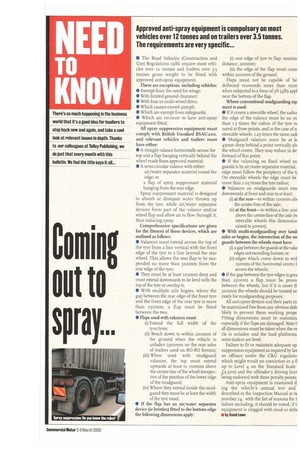N O EE OW • The Road Vehicles (Construction and Use) Regulations
Page 33

If you've noticed an error in this article please click here to report it so we can fix it.
1986 require most vehicles over 12 tonnes and trailers over 3.5 tonnes gross weight to be fitted with approved anti-spray equipment.
There are exceptions, induding vehicles: • Exempt from the need for wings; • With limited ground clearance; • With four or multi-wheel drive; • Which cannot exceed 30mph; • Which are exempt from sideguards; • Which are en-route to have anti-spray equipment fitted.
All spray suppression equipment must comply with British Standard BSALIzoo, and relevant vehicles and trailers must have either: • A straight valance horizontally across the top and a flap hanging vertically behind the wheel made from approved material; • A semi-circular valance with either: air/water separator material round the edge; or a flap of spray suppressant material hanging from the rear edge.
Spray suppressant material is designed to absorb or dissipate water thrown up from the tyre, while air/water separator devices form part of the valance and/or wheel flap and allow air to flow through it, thus reducing spray Comprehensive specifications are given for the fitment of these devices, which are outlined as follows: • Valances must extend across the top of the tyre from a line vertical with the front edge of the tyre to a line beyond the rear wheel. This allows the rear flap to be suspended no more than 3oomm from the rear edge of the tyre; • They must be at least roomm deep and must extend downwards to be level with the top of the tyre or overlap it; • With multiple axle bogies, where the gap between the rear edge of the front tyre and the front edge of the rear tyre is more than 2.5omm, a flap must be fitted between the two.
• Flaps used with valances must: (i) Extend the full width of the tyre/tyres; (ii) Reach down to within zoomm of the ground when the vehicle is unladen (3oomm on the rear axles of trailers used on RO-RO ferries); (iii) When used with mudguard valances, the top must extend upwards at least to toomm above the centre-line of the wheel irrespective of the position of the lower edge of the mudguard; (iv) Where they extend inside the mudguard they must be at least the width of the tyre tread; • If the flap has an air/water separator device (le bristles) fitted to the bottom edge the following dimensions apply:
rear edge of tyre to flap: maxim, distance, 200MM; (ii) the edge of the flap must come within 2oomm of the ground.
Flaps must not be capable of be deflected rearwards more than Toon when subjected to a force of 3N (41b) appl near the bottom of the flap.
Where conventional mudguarding &it merit is used: • If it covers a steerable wheel, the raditt the edge of the valance must be no m than 1.5 times the radius of the tyre m sured at three points, and in the case of n steerable wheels, 1.25 times the same radi • Mudguard valances must be at le 45mm deep behind a point vertically abi the wheel centre. They may reduce in de: forward of this point; • If the valancing on fixed wheel rn. guards is by air/water separator material, edge must follow the periphery of the t) On steerable wheels the edge must be more than 1.o5 times the tyre radius; • Valances on mudguards must exte downwards at front and rear to at least: (i) at the rear—to within momm ab the centre-line of the axle;
(ii) at the front—to within a line zon above the centre-line of the axle ON steerable wheels this dimensior raised to 30mm); • With multi-mudguarding over -land axles or bogies, the intersection of the mi guards between the wheels must have:
(i) a gap between the guards at the vain edges not exceeding Gomm; or (ii) edges which come down to witl i5omm of the horizontal centre across the wheels; • If the gap between the tyre edges is grea than 2.5omm a flap must be provic between the wheels, but if it is more t1-. 300mm the wheels should be treated se rately for mudguarding purposes.
All anti-spray devices and their parts m be maintained free from any obvious deft likely to prevent them working prope Fitting dimensions must be maintain especially if the flaps are damaged. Note tl all dimensions must be taken when the ve de is unladen and the load platforms semi-trailers are level.
Failure to fit or maintain adequate sp. suppression equipment as required by lay an offence under the C&U regulatio which might result on conviction in a fi up to Level 4 on the Standard Scale L'2,5o0) and the offender's driving licer being endorsed with three penalty points.
Anti-spray equipment is examined d ing the vehicle's annual test and described in the Inspection Manual at it number 14, with the list of reasons for t failure including, it should be noted, if t] equipment is clogged with mud or debi
• by David Lowe








































































































